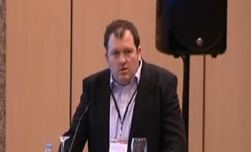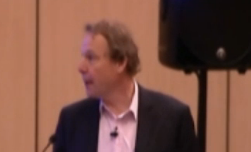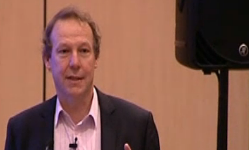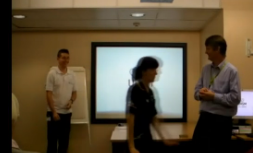Description:
In January 2016, the CEO of NETWORKS Sullivan Partnership, the economic development organization that serves Bristol, Bluff City, Kingsport and Sullivan County, contracted a viral infection called aspergillosis that landed the 52-year-old in Holston Valley Medical Center. He was placed in a drug-induced coma.
The experience was a “gift” that gave him a deeper sense of love, family and community, Walker said.
“I don’t get sick often,” he said Monday from NETWORKS’ Kingsport office. “I don’t miss work. I literally never missed a day of high school. So when I woke up in the intensive care unit hooked up to a ventilator with my mom — who lives six hours away — sitting beside me, I was confused to say the least.”
Aspergillosis is caused by a type of mold that, when left untreated, is usually fatal, according to the Mayo Clinic’s website. Walker, who had been sick since August 2015, explained that his doctor wasn’t looking for the virus because it normally attacks those with weakened immune systems.
“An infectious disease specialist told me that I was really not even a candidate to get the virus,” Walker said. “It usually only affects people whose immune systems have been compromised in some way — people in poor health or certain types of cancer survivors. We’ll probably never know how I got it — but fortunately they knew how to cure it — which is the thing that I’m really thankful for.”
Walker said he had been working long hours before he started feeling ill, but because he was pretty healthy he chalked his symptoms up to simple fatigue. After a few weeks of not getting any better, he visited an urgent care, where he was treated for allergies. By the beginning of winter, he was still sick so he made an appointment with his doctor.
“By November, I was so sick it was a struggle for me to climb the steps to my loft,” he said. “And once I was inside I would fall out from exhaustion so I went back to the doctor. He’d treat me and I’d get better for a little while. Then I’d get sick again only I’d be worse than I had been before. By January, there were several nights that I could barely catch my breath. One night about 11 o’clock I called Brian [Ritz, NETWORKS program manager] and asked him to take me to the hospital because it was so bad.”
Ritz, who arrived within minutes, said there was no way to describe the way he felt when he got Walker’s call.
“I was extremely worried when he called me,” he explained. “But when I saw Clay I knew he was a pretty sick guy and needed medical attention quickly.”
Walker was emotional as he recalled that night’s events.
“Brian took one look at me and said he was going to call an ambulance,” he said. “When the EMTs put the oxygen mask on me it was like giving a man in the desert a drink of water. The doctors told me that call to 911 probably saved my life.”
The last thing he remembers that night was seeing the ceiling and the lights in the emergency room. He gave Ritz his wallet and phone and asked him to check on him the following morning.
“My next conscious experience was waking up with my mother sitting beside my bed. Seeing the confusion on my face — she asked me what day it was and I didn’t know. That’s when I found it was Thursday and I had been in an induced coma for six days.”
That’s when he began to realize what it meant to feel the prayers of others, he said.
“I hope that’s one thing I never forget,” he said. “I could feel the prayers that had been prayed. Feeling those prayers was as real as feeling this table in front of me. I wish I had the words to adequately describe it.”
Walker said the first two weeks after he “woke up” were spent in the hospital. When he was released, he faced two months of recovery at home.
“When I started feeling better, the first person I called was my son, Ty,” said Walker again holding back tears. “I was lying in the hospital with this gross, coughing up this gross black stuff. I was thinking that I didn’t care if I got better. Then I thought about my son — he’s going to turn 26 next month — and I thought, ‘he’s not ready to be without a dad.’ He’s the most important person in the world to me. Thinking about him is what got me through this.”
He added that there was an overwhelming outpouring of support for him and his family during his hospital stay and illness.
A fan of country star Tim McGraw, Walker said there are two songs that he listens to differently since his ordeal. One is called “If I die today” the other is “Live like you were dying.”
“One says I wonder who I’d see crying standing over me and who would just send their regard,” Walker said. “The other talks about being the kind of friend I’d like to be. So now I hug people and tell them I love them more often than not. I’ve learned that it’s stupid to not to tell people how you feel about them. I also found out that the people that I considered friends considered me as a friend as well. And that means a great deal.”
Walker applauded his staff for the work they did while he was recovering and called them an amazing team.
“I’ve been in economic development for 20 years and this has been the best professional year of my life,” he said.
Walker said it’s unlikely he’ll ever get the virus again but he’s taking better care of himself so he can fulfill his purpose while he’s still here.
“I’ve lost about 18 pounds and am continuing to lose,” he said. “I work out and have gotten my blood pressure down. It’s something I have to work at but it’s worth it. God allows things in your life. And when those things happen we’re supposed to do something with it.”
He smiled when he said he believes that his purpose is to be a dad to his son, make an impact on this community and people in his life.
“We’re not promised tomorrow or even the end of the day,” he said. “So, what are we going to do while we’re here? I think it has everything to do with helping people. That doesn’t have anything to do with your bank account or accolades. It has everything do with our relationship to others.”
Medical and Patient education videos
-
Title
Description
-

Part 8 of the Management of chronic and allergic pulmonary aspergillosis. Clinical failure and management – how to manage patients who have not responded to standard antifungals. by Prof David Denning. As presented at the 5th AAA meeting in Istanbul 25th January 2012.
-

Management of allergic and chronic pulmonary aspergillosis. Toxicity of tri-azole antifungals. Dr Caroline Baxter at the 5th Advances Against Aspergillosis..
-

Management of chronic and allergic pulmonary aspergillosis. Masterclass part 6 Antifungal side effects and toxicities. Prof Denning & Dr Caroline Baxter at the 5th Advances Against Aspergillosis.
-

Management of allergic and chronic pulmonary aspergillosis. Masterclass part 5. Antifungal drug monitoring and azole dose modification. By Tim Felton at the 5th Advances Against Aspergillosis.
-

Management of allergic and chronic pulmonary aspergillosis. Masterclass part 4: Approaches to therapy by Prof David Denning. Presented at 5th Advances Against Aspergillosis conference in Istanbul January 2012
-

Management of allergic and chronic pulmonary aspergillosis masterclass by Prof David Denning, presented at AAA conference in Istanbul january 2012. Part 1 Clinical and Radiological presentation & diagnosis.
-

The first Aspergillosis for Patients Meeting was held in Rome on Feb 3rd, 2010. Many internationally renowned scientists and doctors gave an excellent review of Aspergillosis and the latest research and treatments at a level that was designed to be understandable by laypeople rather than doctors. Some talks are now also available as podcasts at the iTunes store – search for “aspergillus and aspergillosis podcasts”.
-

A summary of the potential health impacts of living in a damp home: Video provided by US companies with a financial interest in remediating homes so some marketing of specific services is featured. The Aspergillus Website does not endorse these specific services and care should be taken when employing anyone to carry out this type of work on your home.
-

A collection of video and audio resources intended for patients consisting of self help, patients own stories and patient conference talks.
-

A patient interview. This patient RW- with long term chronic pulmonary aspergillosis describes his experiences over 18 years during which he has taken various antifungal treatments. He remains well and currently takes itraconazole. A synopsis is shown below. This patient underwent a lung resection in 1991 for a suspect lesion in his lung, histology revealed inflammation and an area containing fungal hyphae consistent with a fungal ball. Resection appeared to cure the problem. However in 1992 he re-presented with a large new cavity near the site of the surgery and a probable fungal ball seen on X ray. A bronchoscopy sample grew aspergillus and his blood tests were positive for aspergillus precipitins. Chronic pulmonary aspergillosis was diagnosed. Antifungal treatment on itraconazole was started and much improvement was seen. During the next few years the patient tried voriconazole (as a trial drug) – on which he experienced a red facial rash; IV amphotericin – which improved his condition markedly. Itraconazole treatment was then restarted and the patient has been largely stable on this antifungal drug over the last 13 years. On the occasions he has stopped the drug – he has relapsed and it has taken some months before he was again stable. The patient is currently in good health (11/09). We would like to thank the patient for agreeing to share his experiences.
